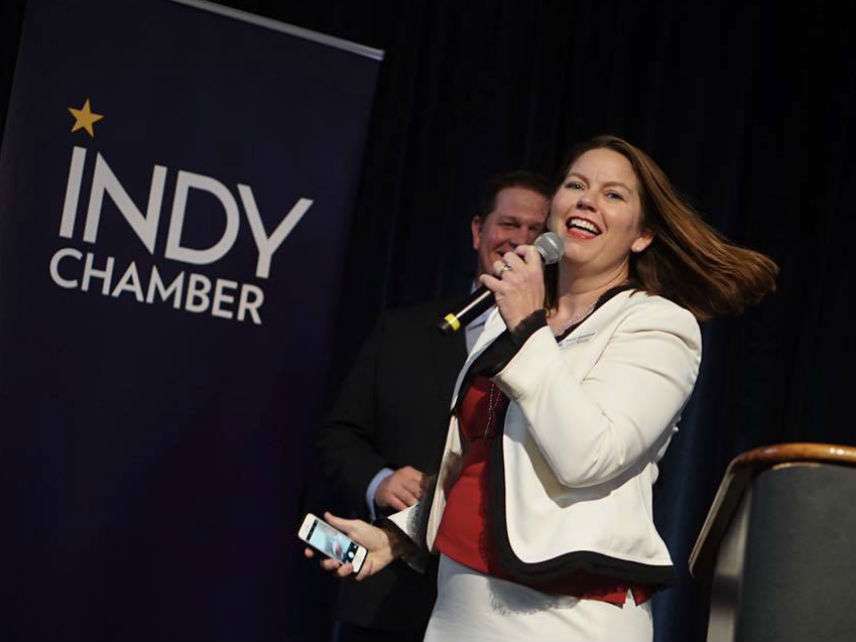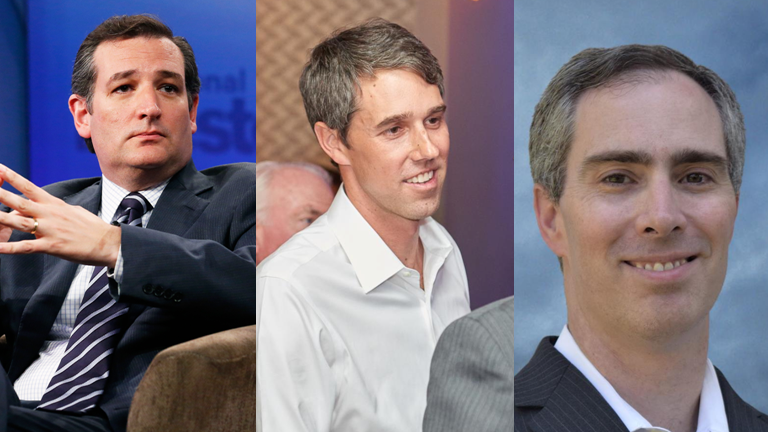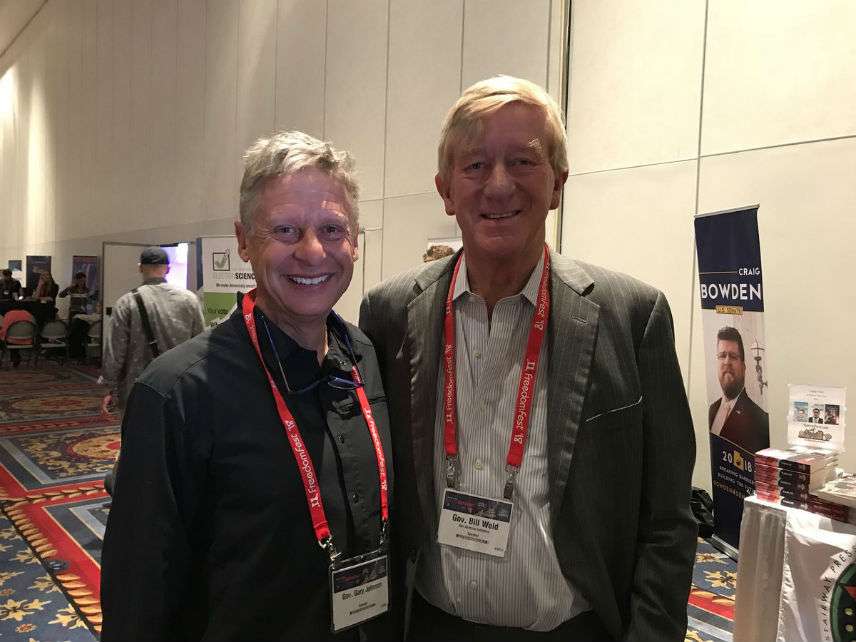Libertarians Cover the Polling Spread in 4 Senate Races
It's running strong candidates in toss-up races in a historically tight election year, yet America's third party still finds itself routinely left off polls.
It's five weeks before election day, and we have no idea which political party will control the U.S. Senate come January. FiveThirtyEight reckons that the two likeliest scenarios are for Republicans to maintain their razor-thin 51-49 margin, or for there to be a 50–50 split, with Vice President Mike Pence ready to break all ties.
A safer bet, though it's one few political analysts are currently talking about, is that candidates from America's perennial bronze medalist, the Libertarian Party, will receive more votes in multiple Senate races than the distance between Republicans and Democrats.
Seventeen Libertarians are running for Senate. They're running in three of the five most "toss-up" states (Nevada, Indiana, and Missouri), and they're running in three other races that at least one forecaster has rated a coinflip (Texas, Montana, and New Jersey). With the stakes of Senate control so high—Supreme Court confirmations! impeachment trials!—the opportunities to scream "SPOILER!" may soon abound.
And yet even strong Libertarian candidates in close races are routinely not being polled. Just this morning saw the release of two close polls between embattled New Jersey Democratic incumbent Robert Menendez and Republican challenger Bob Hugin that did not include the Ron Paul–endorsed Libertarian, Murray Sabrin. In the only nonpartisan survey that all three candidates appeared in, Sabrin's 3 percent cleared the distance between Menendez's 45 and Hugin's 43.
Because of the paucity of polling data, as well as the usual third-party fade on election day, plus some wildly divergent partisan numbers in states like Gary Johnson's New Mexico (where a recent campaign-affiliated poll looked considerably more promising than the last straight survey), the following list should not be mistaken for anything like a prediction. Consider it rather a Polaroid-quality snapshot of the potential for Libertarians to be yelled at come November 7.
A note about the numbers below: Where given the opportunity, I choose "likely voters" over "registered voters," and with the noted exceptions of Montana and Nebraska, I exclude from consideration surveys paid for by campaigns or political parties.
With that said, here are the 17 Libertarian candidacies for U.S. Senate, ranked in order of how much they clear (or get close to) the polling point spread between Democrats and Republicans.

1) Indiana, +5.0.
D Joe Donnelly (incumbent) 43.5 percent, R Mike Braun 43 percent, L Lucy Brenton 5.5 percent (2 polls)
Race forecast: "toss-up," according to 9 out of the 10 prognosticators aggregated by Wikipedia's 2018 U.S. Senate elections page
Brenton, who received 5.5 percent as a Senate candidate in 2016, will be participating in televised debates this month. In the one poll that asked both with and without her name, her inclusion cut three percentage points off Donnelly's lead.
2) Montana, +4.0.
D Jon Tester (I) 44 percent, R Matt Rosendale 44 percent, L Rick Breckenridge 4 percent (1 GOP poll)
Race forecast: 6/10 lean Ds, 2 toss-ups
As mentioned, I exclude partisan polls in the rest of this exercise. So why include it here? Because this Axis Research survey from two weeks ago is the only damn poll to include the Libertarian. Montana's a pretty Libertarian-friendly state: Dan Cox got 6.6 percent of the vote for this seat in 2012, and Gary Johnson received 5.6 percent for president in 2016, his fifth-best result. If I was betting against the spread, I'd take the over.
3) Nevada, +1.4.
D Jacky Rosen 43 percent, R Dean Heller (I) 41.7 percent, L Tim Hagan 2.7 percent (3 polls)
Race forecast: the only unanimous toss-up contest in the country
Hagan has run for elected office nine times, never once receiving less than 3 percent of the vote.
4) New Jersey, +1.0
D Robert Menendez (I) 45 percent, R Bob Hugin 43 percent, L Murray Sabrin 3 percent (1 poll)
Race forecast: "likely D" 7/10, toss-up 1
This race is only competitive in this heavily Democratic state because Menendez is widely seen as skeevy and corrupt. Sabrin got 4.7 percent of the vote for New Jersey governor in 1997, and he got 19.4 percent in the GOP primary for Senate in 2014.
5) Missouri, -0.3.
D Claire McCaskill (I) 45 percent, R Josh Hawley 41.7 percent, L Japheth Campbell 3 percent (3 polls)
Race forecast: 9/10 toss-up
In the two polls that ask both with and without Japheth Campbell, the race goes from tied (without) to a 3.5-point lead for McCaskill.

6) Texas, -2.0.
R Ted Cruz (I) 42.7 percent, D Beto O'Rourke 39 percent, L Neal Dikeman 1.7 percent (3 polls)
Race forecast: lean R 6/10, toss-up 3
Libertarian John Jay Myers won 2.1 percent of the vote last time this seat came up. Rebecca Paddock got 2.9 percent for Senate in 2014. "It will be the Libertarian voters who win this race," Dikeman recently told the Texas Tribune.
7) West Virginia, -5.0.
D Joe Manchin (I) 46 percent, R Patrick Morrissey 38 percent, L Rusty Hollen 3 percent (1 poll)
Race forecast: lean D 8/10
Rusty Hollen has also appeared in two partisan polls, one Democrat and one Republican, and the average there is very similar: 48.5 percent to 40 percent to 3 percent.

8) New Mexico, -6.0.
D Martin Heinrich (I) 43 percent, L Gary Johnson 18.5 percent, R Mick Rich 18.5 percent (2 polls)
Race forecast: 9/10 safe D
Hold on a galdarned minute, wasn't this race closer? Well, it depends. There have only been two nonpartisan polls since the 2012/2016 former L.P. presidential candidate (and two-time former New Mexico governor) jumped in the race, and they differ wildly about Johnson and Rich: 21 percent to 11 percent in the first, 16 percent to 26 percent in the second. Meanwhile, polls sponsored by Democrats and Republicans average out to 45.5–29.5–21 for Heinrich-Rich-Johnson, and three polls taken by Johnson confidant Ron Nielson, including one released last week, show Rich lagging in third: 37.3–26.3–16, on average. If the latter numbers were mirrored by nonpartisan polling outfits, Johnson would be tied for first on this list.
9) Ohio, -11.0.
D Sherrod Brown (I) 49 percent, R Jim Renacci 35 percent, L Bruce Jaynes 4 percent, G Philena Farley 2 percent (1 poll)
Race forecast: 6/10 likely D
Ohio has been among the toughest states for the Libertarian Party, largely because of major-party ballot-access stiff-arming led by Republican Gov. John Kasich.
10) Virginia, -14.0.
D Tim Kaine (I) 50.7 percent, R Corey Stewart 32 percent, L Matt Waters 4.7 percent (3 polls)
Race forecast: 9/10 safe D
Corey Stewart, you may recall, is the super-Trumpy fellow who croaked liberty-movement Republican Nick Freitas in the GOP primary. Waters, who comes across as a libertarian-leaning conservative Normal, is the Libertarian candidate I predict is most likely to top his poll numbers on election day.
11) Pennsylvania, -16.7.
D Bob Casey, Jr. (I) 49.7 percent, R Lou Barletta 31.3 percent, L Dale Kerns 1.7 percent, G Neal Gale 1.3 percent (3 polls)
Race forecast: 7/10 likely D
Pennsylvania is one of eight states left to have the straight-ticket ballot option, which tends to be deadly for third parties.
12) Mississippi, -20.0.
R Roger Wicker (I) 53 percent, D David Baria 32 percent, Ref. Shawn O'Hara 2 percent, L Danny Bedwell 1 percent (1 poll)
Race forecast: 9/10 safe R
Danny Bedwell ran for Congress twice, receiving 1.2 percent in 2012 and 2.5 percent in 2014.
13) Nebraska, -20ish?
R Deb Fischer (I) 52 percent, D Jane Raybould 31 percent, L Jim Schultz unpolled (3 polls, all partisan)
Race forecast: 8/10 safe R
What a godawful disgrace polling in the state of Nebraska is. The Libertarian Party hasn't had many Senate candidates here of late, but Gary Johnson won 4.6 percent of the vote in 2016, and State Sen. Laura Ebke, after switching from the GOP to the L.P. in 2016, is fighting off a Republican in her re-election bid. Articles about Jim Schultz have headlines like "There is a third choice for Senate on the November ballot."
14) Connecticut, -22ish?
D Chris Murphy (I) 56.5 percent, R Matthew Corey 34 percent, L Richard Lion unpolled (2 polls)
Race forecast: 9/10 safe D
Besides Richard Lion, two other candidates on the ballot are not being polled: the Green Party's Jeff Russell and Socialist Action's Fred "Mitch" Linck. Lion received 1.1 percent of the vote for U.S. Senate in 2016.
15) Utah, -30.5.
R Mitt Romney 57 percent, D Jenny Wilson 24 percent, C Tim Aalders 3 percent, L Craig Bowden 2.5 percent, IA Reed McCandless 2.5 percent (2 polls)
Race forecast: 9/10 safe R
Craig Bowden received 5.9 percent of the vote for the House of Representatives in 2016.
16) Delaware, -34.0.
D Tom Carper (I) 61 percent, R Rob Arlett 24 percent, L Nadine Frost 3 percent, G Demetri Theodoropoulos 3 percent (1 poll)
Race forecast: 9/10 safe D
"I am running because I love my grandchildren and I want them to have a better future," Nadine Frost says.
17) Maryland, -38.0.
D Ben Cardin (I) 56 percent, R Tony Campbell 17 percent, I Neal Simon 8 percent, L Arvin Vohra 1 percent (1 poll)
Race forecast: 9/10 safe D
This is the only of the Libertarian Party's 17 races for U.S. Senate in which the Libertarian is not within one percentage point of third place in the polls. Vohra, the party's most controversial figure over the past two years, was voted out of office as national vice chair three months ago and is an announced candidate for the 2020 presidential nomination.
Show Comments (77)